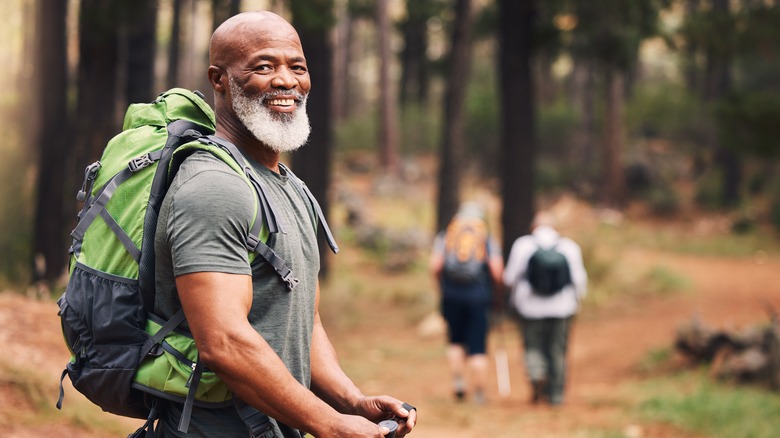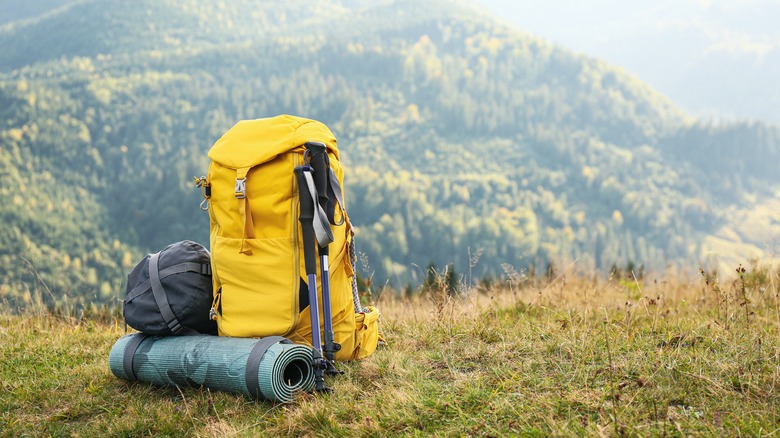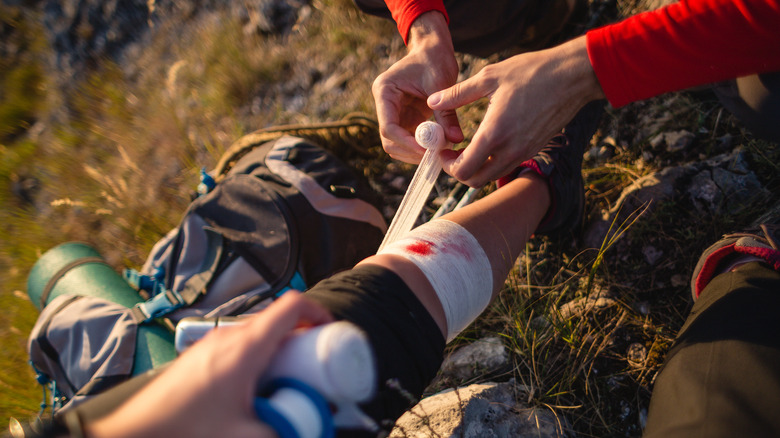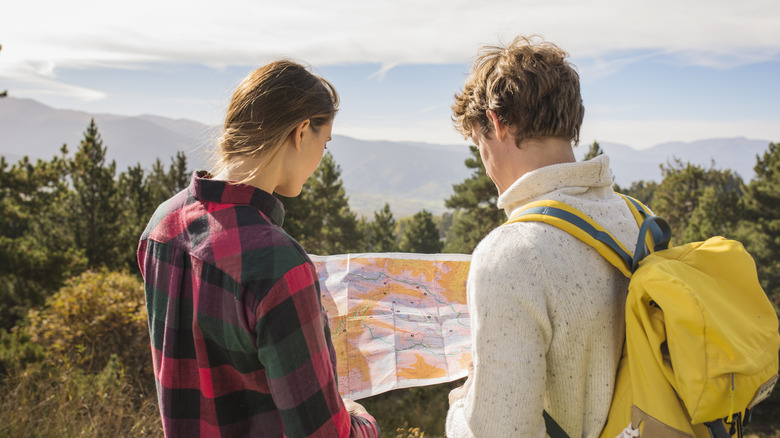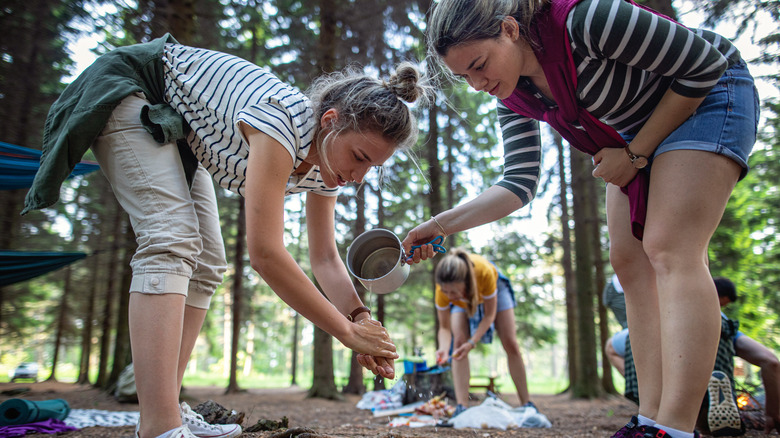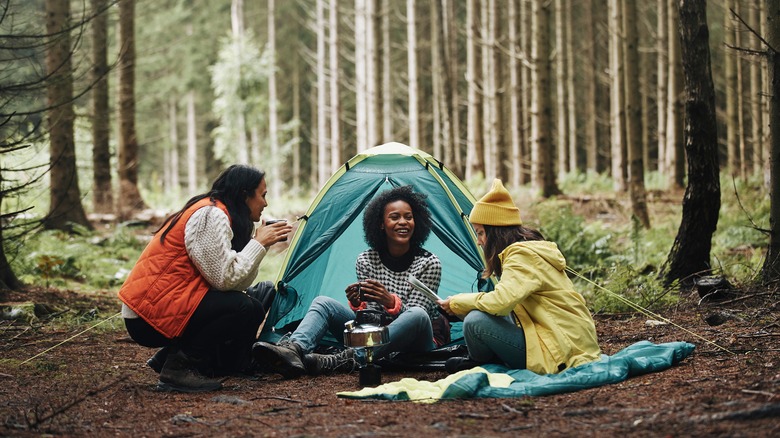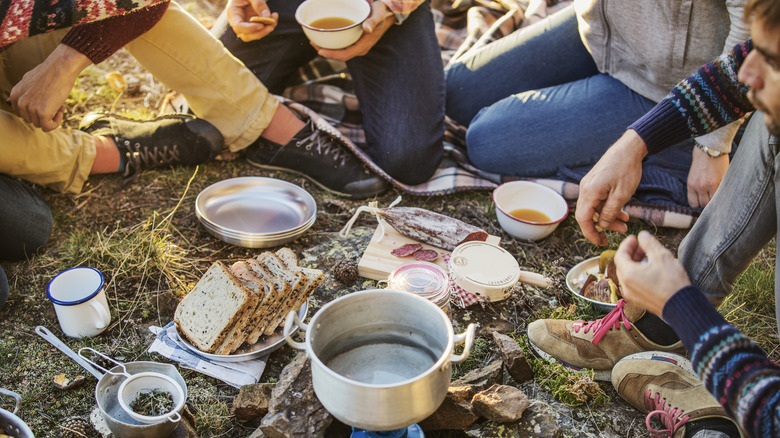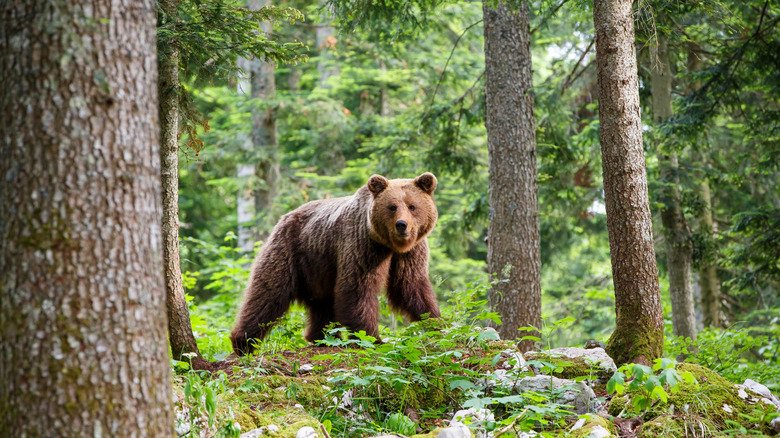Everything You Need To Know Before Taking A Solo Backpacking Trip
Picture this: the sun rising over majestic mountain peaks, casting a warm glow on pristine wilderness. You stand alone, surrounded by nature's grandeur, and the world feels both vast and intimately connected. This is the charm of solo backpacking, a thrilling adventure that beckons those with a thirst for exploration and a yearning to discover themselves in the heart of the great outdoors.
The decision to venture into the wild alone may seem daunting, but it's precisely the allure of the unknown and the prospect of charting one's course through unexplored territory that captivates the adventurous soul. Solo backpacking is more than just a physical journey; it's an opportunity to disconnect from the constant barrage of screens, schedules, and responsibilities and reconnect with the rhythms of nature. It's a pursuit that requires a blend of physical resilience, mental fortitude, and unwavering determination.
If you're a first-time adventurer contemplating this thrilling escapade, we've got you covered with valuable insights and expert tips that will empower you to prepare effectively, stay safe, and extract the utmost enjoyment from your solo backpacking experience. So, fasten your metaphorical backpack, tighten your shoelaces, and get ready to traverse the terrains of solo backpacking. Your adventure begins here, where the wild calls and the heart answers.
Choose a well-traveled destination
Selecting the right destination for your solo backpacking adventure is a crucial step. It can make or break your experience. Your destination should align with your interests and goals for your trip. Do you prefer challenging hikes in remote wilderness, or do you want to explore cultural and historical sites? Understanding what excites you, and choosing a location that entices you will result in a more rewarding journey.
For first-time solo backpackers, skill level and safety should also be at the forefront of your decision-making process. Consider selecting an easy, well-maintained and well-traveled destination. Since you are already challenging yourself by stepping into uncharted waters, selecting a well-traveled trail can help ease your preparation and enhance your backpacking experience. These popular routes tend to offer relatively easier logistics and readily available information. You'll find abundant resources and fellow hikers who can provide insights and guidance, which can be immensely reassuring, especially for newcomers. It's also worth noting that tackling a challenging terrain as your first solo backpacking experience might lead to frustration and potentially deter you from reaping the rewards of this adventure. By starting with an easier trail, you can build your confidence and develop the skills necessary for more demanding journeys in the future.
Some renowned destinations that have garnered acclaim among novice backpackers include the Lost Coast Trail in California, the Ancient Lakes in Washington, and the Sandbeach Lake in Colorado. These trails offer a harmonious blend of natural splendor and cultural exploration, making them enticing options for solo adventurers.
Pick a convenient time
Selecting the right timing for your solo backpacking trip is as crucial as choosing the destination. It involves careful consideration of both environmental factors and personal circumstances. Begin by researching the weather and climate patterns for your chosen destination. Ensure your trip is planned during a season that provides favorable conditions for your outdoor activities while avoiding extreme weather conditions or seasons with a heightened risk of natural disasters. For example, trekking through the American west coast in the summer is an excellent idea, but the same time of year will have you sweaty and sticky in Texas.
Moreover, it's essential to acknowledge that while we may yearn for the freedom to set aside all our routine commitments, real life often necessitates that we balance our personal obligations. Thus, contemplate your personal life and duties as you schedule your adventure. Are arrangements for family care, work-related responsibilities, or health concerns to be made? Ensure that the timing and length of your solo backpacking journey align harmoniously with these commitments, allowing you to embark on your adventure with peace of mind.
Balance forethought with fluidity
One of the primary challenges faced in the realm of solo backpacking is discovering the delicate equilibrium between meticulous planning and the allure of spontaneity. Thorough research is undeniably crucial for ensuring a safe and enjoyable journey. However, when one becomes excessively ensnared by rigidity, the true spirit of adventure can be inadvertently smothered. Reflect on the kind of person you are and the person you want to be while on this trip; do you get bogged down with anxiety if details are left hanging? Or are you challenging yourself to be more spontaneous? To strike this delicate balance effectively, consider the following approach.
Commence by crafting a well-thought-out itinerary that encompasses the routes you intend to traverse, the number of days you'll need to complete your trail comfortably, your lodging arrangements, and the acquisition of any necessary permits. In the wilderness, knowledge emerges as your most reliable ally. Simultaneously, fashion a contingency plan to serve as your compass should unforeseen events like natural disasters or health and political conflicts materialize. Contingencies may encompass unexpected extreme weather conditions, injuries, or modifications in your intended schedule.
Yet, amid all the planning, it's vital not to lose sight of the exquisite joy of embracing unforeseen adventures. Some of the most cherished and memorable moments in solo backpacking are those that unfurl spontaneously. Be open to opportunities that arise at the moment, such as deciding to join a fellow adventurer for part of their journey. These unscripted interludes often etch themselves most profoundly in the tapestry of your solo backpacking experience.
Pack reputable gear
The gear you select can make all the difference between a solo backpacking trip that flows seamlessly and one filled with challenges. It's crucial to have the correct equipment while also managing your load efficiently. But what exactly do we mean by "the right gear"? We're referring to equipment that has undergone scrutiny from seasoned backpackers. To ensure you make the best choices, explore blogs, TikTok videos, and YouTube channels created by backpackers who have ventured on trips similar to the one you're planning. This will give you a more accurate picture of which gear is applicable to you. While doing so, consider the potential influence of sponsorship, though nowadays, most influencers and reviewers prioritize honesty to maintain their credibility.
When crafting your gear list, several essentials should not be overlooked. These include a reliable backpack, suitable shelter, a well-insulated sleeping bag, cooking equipment, and clothing tailored to the season and destination you're heading to. If your journey spans an extended period, managing weight becomes paramount. Carrying superfluous items can take a toll on your physical stamina while omitting essential gear can compromise your safety and overall comfort. Therefore, investing in lightweight and durable equipment is a wise choice. Modern backpacking gear is meticulously designed for both efficiency and durability, ensuring you can carry what you need without being burdened by excessive weight.
Lastly, never embark on your journey without a well-stocked first aid kit; ensure you know how to use it. Basic medical understanding can be invaluable in the wilderness, providing a safety net in unexpected situations.
Condition your body
Embarking on a backpacking adventure is far from a walk in the park, and even standing in airport lines with a 45L backpack can be surprisingly tiring. The physical demands of your journey will largely depend on its length and level of difficulty. It's vital to understand that training for backpacking is different from training for regular hiking. To get yourself in the best shape for your adventure, you should concentrate on strengthening your cardiovascular endurance, leg muscles, and core. Your training regimen should encompass a mix of strength, flexibility, and endurance exercises. These will prepare your body for the diverse physical demands of backpacking.
Your training should closely mimic the type of physical activity you'll engage in during your journey. This ensures that your muscles are familiar with the movements they will undertake, preventing soreness and exhaustion. For instance, if you'll be ascending steep terrain, incorporate uphill training into your routine.
Begin your training with a focus on gradual progression. This means gradually increasing distances and intensity of your hikes. Pushing yourself too hard too quickly can lead to injury. Since you want your training to mimic your actual adventure, practice with the equipment you'll be carrying on your trip to become accustomed to its weight and feel, by slowly increasing the number of items you'll need. This is crucial to ensure that your body is prepared for the specific load it will bear.
Prepare yourself mentally
Solo backpacking presents unique mental challenges, as you'll frequently find yourself in solitude, facing unpredictable situations. Building mental resilience is just as vital as physical fitness for a successful journey. Watch and read about other solo traveling experiences. Familiarize yourself with the challenges others have experienced to build your own psychological toolkit.
Before embarking on your journey, establish clear goals for your trip. Knowing why you're undertaking this adventure can provide you with motivation and a sense of purpose during challenging moments. Whether it's to reconnect with nature, test your limits, or find inspiration, having a goal can be a powerful psychological anchor. Cultivate a sense of self-reliance and self-sufficiency, as your decision-making ability and resourcefulness will be your primary tools in unforeseen situations. In addition, solitude can evoke a range of emotions, from serenity to moments of unease. Being aware of these effects can help you navigate them more effectively. If you anticipate that loneliness might be an issue, consider strategies to stay connected with others during your trip. While cell signals may not always be accessible in remote areas, journaling your experiences and taking photos to share later can help alleviate the feeling of isolation. Sharing your adventure with friends and family through these means can provide a comforting sense of connection.
Learn to embrace and even relish moments of solitude. Solo backpacking offers a unique opportunity for self-discovery and introspection. By fostering mental resilience, understanding the unique psychological challenges of solo backpacking, and setting clear intentions for your journey, you can ensure that your mental state is well-prepared to confront and embrace the solitude and unpredictability that often define solo wilderness adventures.
Make sure you have solid safety skills
Ensuring your safety is of paramount importance when embarking on a solo backpacking adventure. It's crucial to address safety concerns, including those that may be specific to your gender, particularly for solo female travelers.
Logistics aside, it's time to talk safety. Well-trodden paths are generally safer and pose a lower risk of exposure to extreme conditions or unforeseen hazards. Don't abandon trails you set your initial sights on. Of course, even on these paths, disaster can strike. Equip yourself with basic first aid and wilderness survival skills. Being prepared for emergencies can make all the difference in a critical situation. Knowing how to tend to injuries, deal with minor mishaps, and navigate unforeseen challenges is essential for your safety and peace of mind.
Last, always share your detailed itinerary with a trusted individual who is aware of your planned route and schedule. In the event that you fail to return as expected, this person can take the necessary actions to ensure your well-being and safety.
Master your navigation skills
In the wild, navigation skills are your compass, ensuring you never lose your way. Modern tools such as maps, GPS, and compasses can be invaluable, but understanding how to use them is key to keeping you on course and preventing you from getting lost. Here's how to navigate and orient yourself effectively.
Maps, GPS devices, and compasses are essential companions. Learning how to read maps and utilize navigation tools can be a game-changer for your safety and ensuring you stay on the right path. Before leaving your campsites, familiarize yourself with maps of the area you'll be traversing. Understand the terrain, landmarks, and key points of interest.
While on the trail, maps are like your trusty guides in the wilderness, providing crucial information about your surroundings. Carrying a GPS device and a compass is crucial for reliable orientation. Apps like AllTrails can also be handy for navigating. These tools can help you pinpoint your location, track your progress, and make informed decisions about your route. Ensure you understand how to use them effectively. While smartphone apps can be helpful, always have backup methods for navigation. Battery failure or technical issues can render your devices useless. Backup maps, a physical compass, and the knowledge of how to use them are essential. Regularly check your map and GPS, paying attention to landmarks and your surroundings. Keeping a constant track of your location is not only helpful for staying on the right path but also essential for your safety.
Embrace responsible hiking etiquette
One of the most gratifying aspects of backpacking is the profound connection with the great outdoors. However, it's essential to remember that with this privilege comes the responsibility of adhering to responsible outdoor ethics. Embracing Leave No Trace (LNT) principles is fundamental for responsible backpacking. These principles serve as your guiding compass to minimize your impact on the environment. They include packing out all your trash, choosing well-established trails and campsites, and being mindful of where you camp. By practicing LNT, you actively protect and preserve the wilderness for generations to come.
Familiarize yourself with the wilderness code of conduct and adhere to it diligently. This code often includes rules about noise levels, campfire regulations, and wildlife interactions. Following this code ensures you are a responsible visitor in the wilderness, promoting harmony with the natural environment. Mindful water consumption is a crucial component of responsible backpacking. Opt for water-efficient hygiene practices to conserve this precious resource. Using water sparingly is both practical and environmentally responsible. Consider bringing a portable water filter or purifier to access clean water without relying on single-use plastic bottles.
By following these responsible hiking etiquette practices, you transform into an environmentally conscious backpacker. Your actions will significantly contribute to the preservation of the wilderness, ensuring that future generations can revel in the splendor of these natural wonders just as you have. Your commitment to responsible outdoor ethics not only enhances your backpacking experience but also safeguards the beauty of the wilderness.
Follow sustainable hygiene practices
Maintaining personal hygiene while backpacking is not just about staying clean; it's also an opportunity to contribute to environmental sustainability. Embracing reusable products is a key step in reducing your impact on the wilderness. Say goodbye to single-use items and opt for their reusable alternatives. Consider packing washable, quick-drying, and durable hygiene products like microfiber towels, cloth menstrual pads, and reusable wipes. Not only do these eco-friendly options reduce waste, but they also save you money in the long run. Develop a comprehensive waste management plan for your trip. Carry small, sealable bags for storing used hygiene products until you can dispose of them properly in designated receptacles. Ensuring responsible waste disposal is crucial for preserving the wilderness. For individuals who menstruate, following hygiene principles in the backcountry is essential. Practice proper disposal methods and ensure you leave no trace when it comes to hygiene products. By using reusable and sustainable menstrual products, you can significantly cut down on waste.
Invest in toiletries and personal care products that come in sustainable packaging. Look for options with recyclable or minimal packaging, and avoid single-use items whenever possible. There is a wide range of eco-friendly toothbrushes, toothpaste, and deodorant available to help you maintain personal hygiene while being environmentally conscious. Opt for biodegradable soaps that break down in the environment, minimizing their impact on water sources and the wilderness. Ensure you follow Leave No Trace principles by washing at least 200 feet away from lakes and streams to protect water quality.
Select accessible campsites
Selecting the perfect campsite in the wilderness is akin to choosing a temporary haven. Access to water is vital for hydration and meal preparation. Opt for a campsite close to a reliable water source. Take your daily hiking plans into account. If you prefer convenience and wish to save time and energy, a campsite near the trail may be your preference. On the other hand, if solitude and tranquility are what you seek, selecting a campsite further from the beaten path might be more appealing.
Look for level ground when setting up your campsite. Avoid slopes or areas near potential hazards such as dead trees that could fall during windy conditions. A level campsite not only ensures your comfort but also your safety. Always respect camping regulations and guidelines specific to your chosen destination. These rules are in place to protect the environment and ensure a safe and enjoyable experience for all. Compliance is not only ethically responsible but also helps maintain the beauty of the wilderness.
By considering these factors, you can choose a campsite that suits your needs and preferences, creating a safe and comfortable base for your solo backpacking adventure. Your campsite becomes your sanctuary amidst the wilderness, offering both shelter and a connection to the natural world.
Plan your meals in advance
Proper meal planning is a critical component of your solo backpacking journey. Select lightweight, nutritious, and easy-to-prepare meals. Dehydrated foods, energy bars, and freeze-dried options are popular choices. Variety is key, ensuring you have different flavors and textures to keep your taste buds excited. Think about balancing carbohydrates, proteins, and fats to provide sustained energy. A well-rounded diet is essential for your stamina during the adventure. If you have dietary restrictions or allergies, ensure your meals are tailored to your needs. There are plenty of options available for various dietary preferences, so plan accordingly.
Proper food storage is essential to prevent unwanted wildlife encounters. Utilize bear-resistant containers or bear bags where necessary. Adhere to local regulations and best practices for securing your food.
A lightweight and compact stove is essential for cooking in the wilderness. It allows you to prepare hot meals and beverages quickly. Opt for cookware that is lightweight and versatile, considering your specific cooking needs. Keep your utensils simple with a lightweight set that includes a spork, knife, and a cup for hot drinks.
Know how to respond to wildlife encounters
Wildlife encounters are a captivating aspect of backpacking in the wilderness, but knowing how to respond is essential for your safety and the well-being of the natural world. If you encounter wildlife, stay calm and avoid sudden movements. Running or making loud noises can irritate or provoke the animal. Maintain a composed demeanor. Always maintain a safe distance from wildlife. Use binoculars or a zoom lens for a closer look if needed, but never approach them. Respect their space and avoid encroaching on their territory.
In areas with bear populations, educate yourself about bear safety protocols. Carry bear spray, make noise on the trail to alert bears to your presence, and store food properly to minimize the risk of attracting them to your campsite. Ensure you store your food, trash, and scented items in bear-resistant containers or designated storage areas. This not only safeguards you but also discourages wildlife from developing a reliance on human food.
Wildlife photography can be a thrilling aspect of backpacking, but always respect the animal's space and avoid disrupting their natural behavior. Use long lenses and maintain a safe distance for both your safety and the well-being of the animal. Respect for wildlife and their habitats is an integral part of responsible backpacking.
